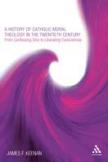Intellectual Innovations
Continuum. 248p $29.95 (paperback)
Participants in sabbatical programs, clergy conferences or workshops for religious educators often ask me to recommend an article or book that will bring them up to speed on recent thinking in moral theology and the roles various contributors have played in developing the field. This book meets that need.
James F. Keenan, S.J., professor of theological ethics at Boston College, is already well known to readers of America. He is a prolific author with that special gift of being able to write for the academy and for people in the pews. His keen insight, fair hand, comprehensive grasp and friendly style make even the most intricate argument accessible to the reader. In this book you will find more of the same.
With this volume, Keenan joins the ranks of John Mahoney (1987) and Charles Curran (1997 and 2008) in providing another towering history of moral theology. Unlike Mahoney, who organized his work thematically, Keenan’s is done by eras: the manualists (Chapter 2), the Re-formers (Chapters 3, 4, 5), the Revisionists (Chapters 6, 7, 8) and global voices (Chapter 9). Whereas Curran restricted himself to developments in the United States, Keenan stretches farther, treating the huge European contribution as well as perspectives from Latin America, Africa, Asia, and feminist and black Catholic theology. There is clear need for a history like this.
One conclusion beyond question in this book is that Catholic moral theology is not monolithic. It has been marked by discontinuity, inconsistency and development. The 20th century witnessed a rich diversity of shifting methods and dialogue partners. Underlying all these differences, however, is a common interest—the search for moral truth. This goal of moral reflection has come to be realized in the sanctuary of our consciences where we hear the call of God to live Christian discipleship through charity.
As the subtitle of the book suggests, the axis of moral truth has shifted from actions to agency. The influential English manuals of Thomas Slater, Henry Davis, Heribert Jone, John Ford and Gerald Kelly that dominated the moral landscape in the first half of the century focused on moral pathology. Moral living was about avoiding sin; moral teaching was about providing norms for right conduct. Missing was the positive orientation to the moral life of responding to God’s call to live virtuously as a disciple of Christ.
The reformers reoriented the moral life by making moral reflection more historical (Odon Lottin), more scriptural (Fritz Tillmann), more spiritual (Gérard Gilleman), more theological (Bernard Häring, Josef Fuchs, Charles Curran) and more personal (Louis Janssens and Alfons Auer). They offered a new identity to moral theology (from avoiding sin to conforming to Christ), a new focus (from action to agency), a new mentality (from classicist to historical consciousness) and a new point of departure (from canon law to theology).
The encyclical Humanae Vitae (1968) marked the turning point in re-examining the method and concepts of the manualists, and in reconsidering the location of moral truth in norms proposed by the magisterium. The turbulent period between Humanae Vitae and Veritatis Splendor (1993) was dominated by intense discussions of the notion of moral objectivity and of the process of moral reasoning. Keenan deftly handles the controversies of this period to show that what distinguished moral positions was not theology but philosophy, especially the anthropology that influenced interpretations of natural law. The essentialist anthropology of the classicists posits an a priori human nature with a fixed end that does not yield to experience or social-scientific claims. For them the principle of action is the laws of nature. For the historically minded revisionists, human nature is not a static object. Rather, human nature is the relational, embodied person in a historical world that we come to know only gradually and partially. The principle of moral action is not a fixed nature but reason discovering moral value by reflecting on experience.
As virtue ethics gained in ascendancy during the latter part of this period, prudence took its rightful place as the foundation of moral objectivity. Moral truth is found where prudence takes into account the totality of the moral reality (act, intention and circumstances, including consequences). In his last chapter, Keenan shows how virtue ethics serves as the most appropriate mode of moral reflection to meet the challenges of cross-cultural dialogue about how to express moral truth.
A History of Catholic Moral Theology in the Twentieth Century is a remarkable achievement. The more I delved into the book the more I was impressed with Keenan’s command of the issues and the literature across the globe. He seems to have omitted no one who has had a hand in shaping the development of moral theology, and he masterfully summarizes their core contributions. Footnotes are in abundance and identify significant works in many languages. This is the book for anyone interested in what has happened in moral theology and in who’s who among its contributors. It is essential reading for graduate students of moral theology, since much of the history narrated here and the theologians who have shaped it remain unknown territory to many of today’s students.
Keenan looks back through our past, not to deconstruct it with harsh criticism but to show us that through a persistent search for moral truth, moral theology is innovative in utilizing valid advances in human knowledge. These new understandings of what it means to be human can then help us to discern the ways God is calling us to live as disciples in charity.
This article also appeared in print, under the headline “Intellectual Innovations,” in the April 5, 2010, issue.








